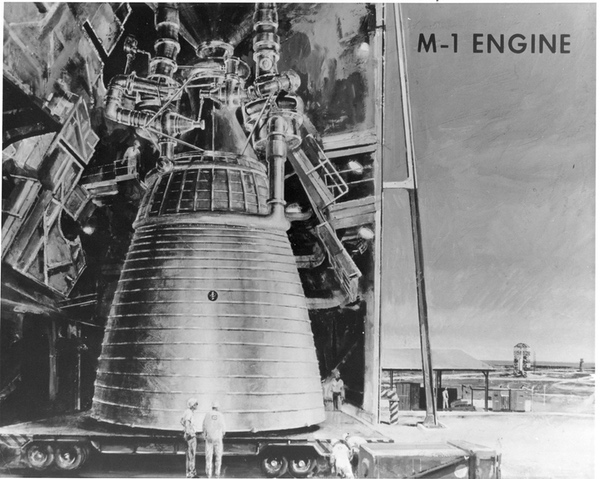M is for MONSTER ROCKET: the M-1 cryogenic engineby Dwayne A. Day
|
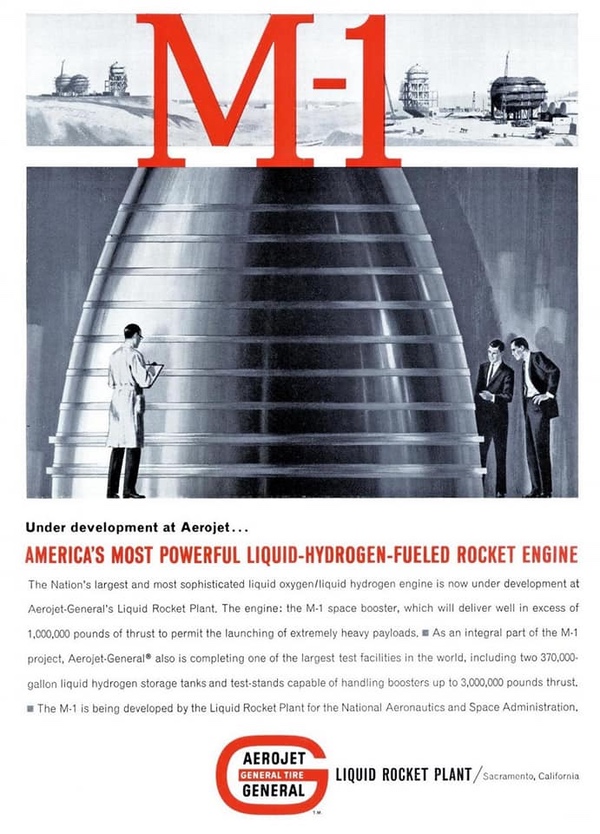 Image from an Aerojet ad for their big new rocket engine. The program experienced cost overruns and did not have a clear requirement. |
Birth of a monster
The engines that eventually powered NASA’s Saturn V rocket originally started as Air Force projects. The F-1 was an Air Force engine, as was the J-2 hydrogen-oxygen engine, and both were eventually incorporated into what later became known as the Saturn V. Initially, the Air Force planned Project Lunex to send humans to the Moon, and a Space Launching System launch vehicle that would take them there. One SLS design used a cluster of twelve J-2 engines for the second stage, but Air Force officials were concerned that this was overly complex and so they contracted Aerojet to begin work on a new engine, named the M-1, with 1.2 million pounds-force (5.3 million newtons) of thrust with the goal of replacing twelve J-2s with two M-1s. When NASA was created in 1958, Army and Air Force projects were gradually turned over to the civilian space agency, eventually including the Saturn and various rocket development projects such as the F-1, as well as ongoing studies of potential rockets such as the M-1.
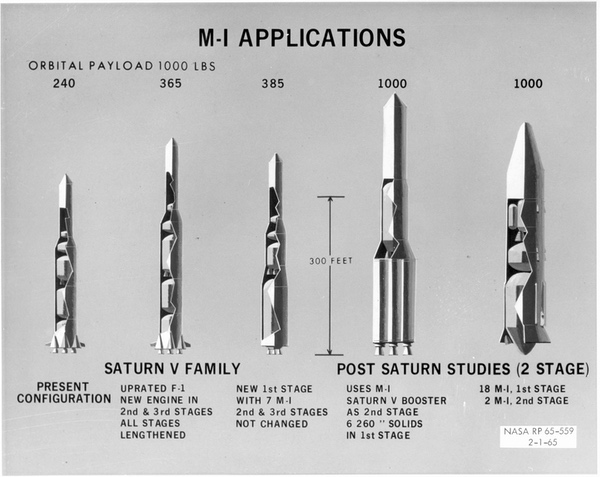 The M-1 was proposed as a possible engine for both upgrades to the Saturn V (replacing the existing J-2 and F-1 engines), and future post-Saturn V rockets. |
Initially NASA engineers believed that, to launch an Apollo Command and Service Module all the way to the lunar surface and bring it back, they would need a large rocket that they named the Nova. But after various iterations of methods of reaching the Moon, they determined that they could accomplish the task with smaller rockets such as the Saturn V. However, even though the Saturn V was going to be the most powerful rocket ever built, NASA engineers kept thinking in terms of even larger rockets that they believed were required for human Mars missions as well as establishing lunar bases and launching large space stations. So, while the Saturn V was under development, they evaluated other large rocket concepts, still under the designation of Nova, although these new Nova concepts bore little relation to the earlier Nova studies.
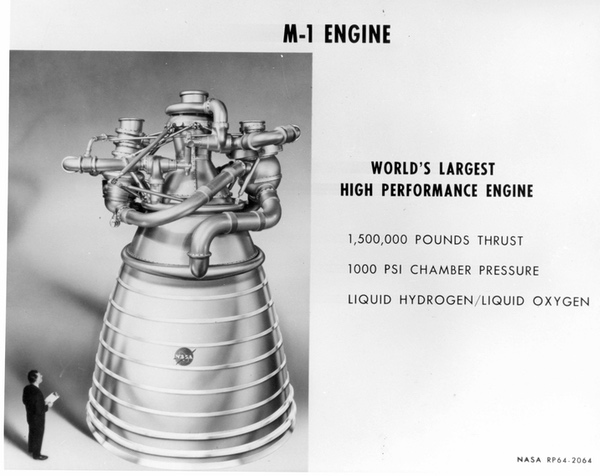 NASA produced artwork and briefing slides to explain the size and power of the M-1 engine. |
By 1962, some at NASA believed that they would need a powerful upper stage engine for a future Nova launch vehicle. Initially this was to be a liquid hydrogen-liquid oxygen engine with 1.2 million pounds-force thrust. But soon NASA engineers determined that the engine should have 1.5 million pounds-force (6.7 million newtons) of thrust, capable of being upgraded to 1.8 million pounds-force (8 million newtons). The goal of the program was to provide a high-performance propulsion system for post-Saturn launch vehicles consistent with having a man-rated system available in the 1970s. But the M-1’s designers also envisioned that it could be used in potential upgrades to the existing Saturn V, replacing the five J-2s on the second stage with a single M-1. Aerojet’s engineers also considered adapting the M-1 as a first stage engine for the Nova.
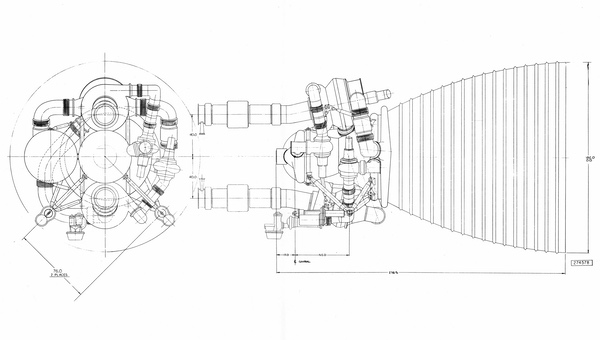 Schematic of the M-1 engine illustrating that unlike the F-1 engine, many of the components were separate and could be tested separately without requiring an entire engine to be constructed before it could be tested. |
The M-1 engine consisted of a single regeneratively-cooled thrust chamber, separate turbopump assemblies driven by separate gas generators—as opposed to a single gas generator driving a common power shaft—and a turbine exhaust cooled nozzle extension. The exhaust from the gas generators was relatively cool compared to the rocket exhaust, and so rather than dumping it overboard it was directed into cooling pipes in the lower part of the engine skirt. It entered the skirt at about 700 degrees F (371 degrees C) and was heated to about 1,000 degrees F (538 degrees C) before being dumped through small nozzles at the end of the skirt.
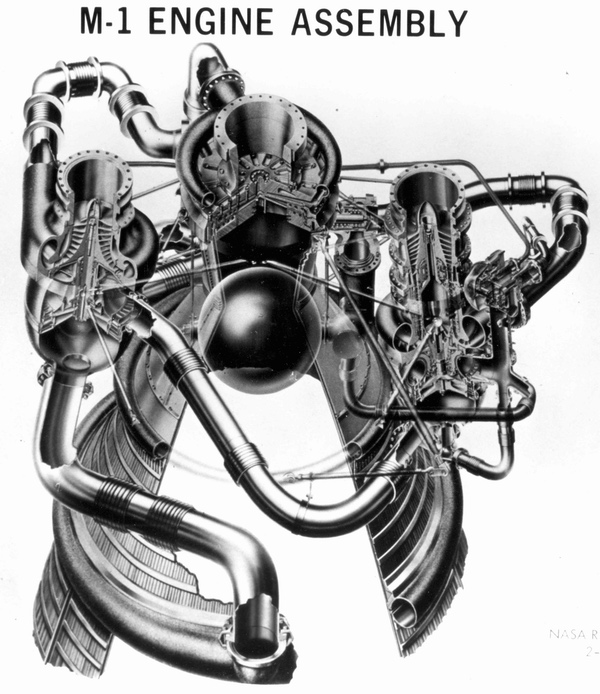 The M-1 engine consisted of a single regeneratively cooled thrust chamber, separate turbopump assemblies driven by separate gas generators, and a turbine exhaust cooled nozzle extension. The exhaust from the gas generators was relatively cool compared to the rocket exhaust, and so rather than dumping it overboard it was directed into cooling pipes in the lower part of the engine skirt. |
Thrust vector control was provided by gimbaling the entire engine assembly. The specific impulse—a measure of fuel efficiency, or how much power could be obtained from a specific unit of fuel—was 428 seconds, considerably more than the 263 seconds for the oxygen-kerosene powered F-1 engine. Because the M-1 was designed to operate in thinner air at high altitudes, it had a very large exhaust nozzle that was considerably bigger than even the large F-1.
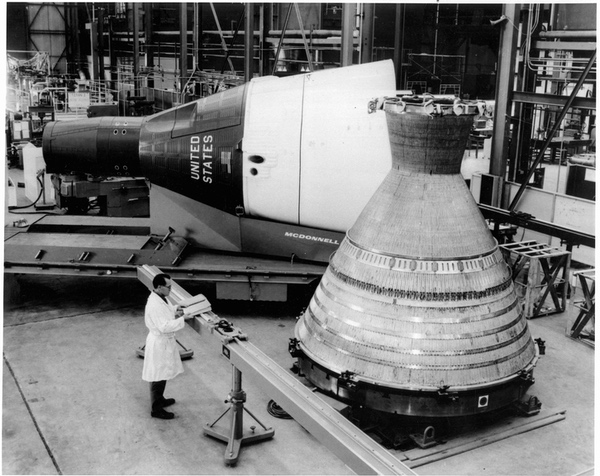 The two-man Gemini spacecraft is displayed next to the upper part of an M-1 engine. The Gemini would have fit within the engine bell of a completed engine. |
Development efforts on the engine began in 1962 and over the next two years Aerojet’s engineers made significant progress, helped in part by the fact that the separate gas generators and turbopumps made it possible to build and test the components separately before they were all integrated together. Aerojet built eight combustion chambers, eleven gas generators, four oxygen pumps, and four hydrogen pumps that were not completed by the time the program was shut down.
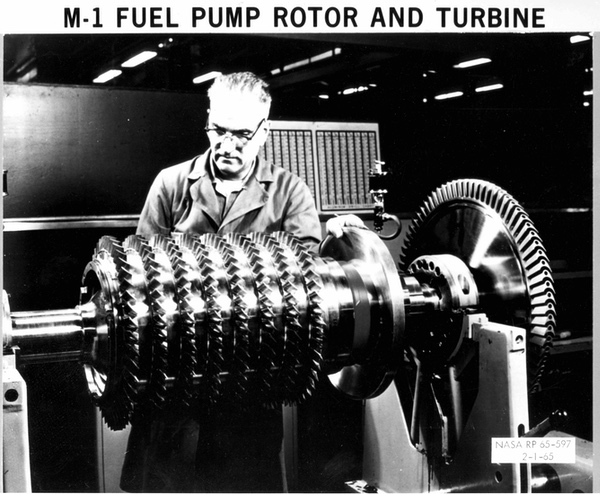 Fuel pump for the M-1 engine. The components were significantly larger than those for any other engine, including the Saturn V's F-1. |
Monster engine, monstrous costs
Aerojet completed system design and analysis by 1963 and progressed to full-scale hardware. In May 1963, Aerojet began testing the M-1’s gas generator, essentially a smaller rocket engine used to power the turbopumps that pumped hydrogen and oxygen into the engine. Full scale engine testing was initially scheduled to begin in early 1966. But by April 1963 a revised NASA development schedule had pushed flights of the M-1 engine back to 1969 or later.
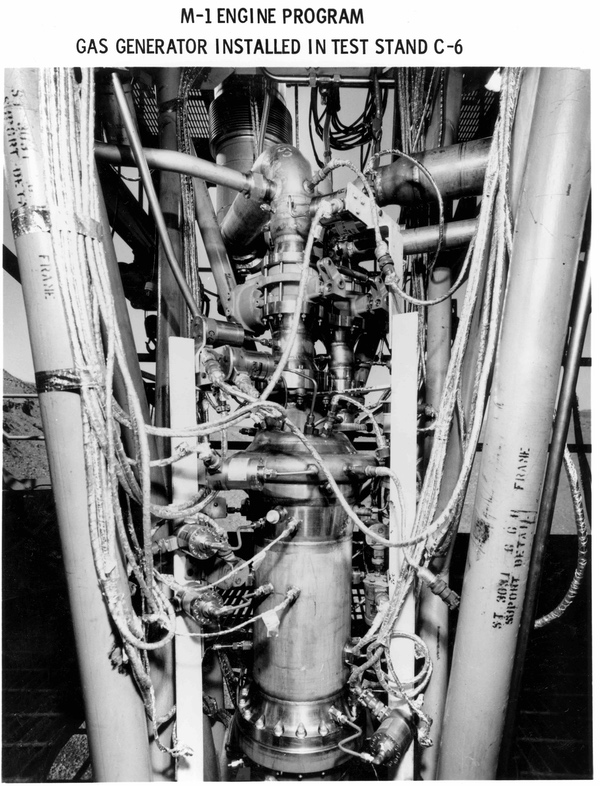 The design of the M-1 enabled components to be hot-fired without having to finish the entire engine. Some components, like this gas generator, were tested. They were equivalent to smaller rocket engines in power. |
In addition to the work on the engine, Aerojet also began construction of facilities for supporting the development program. These included laboratories and fabrication and component test facilities. Aerojet also started construction on three engine system test stands in northern California.
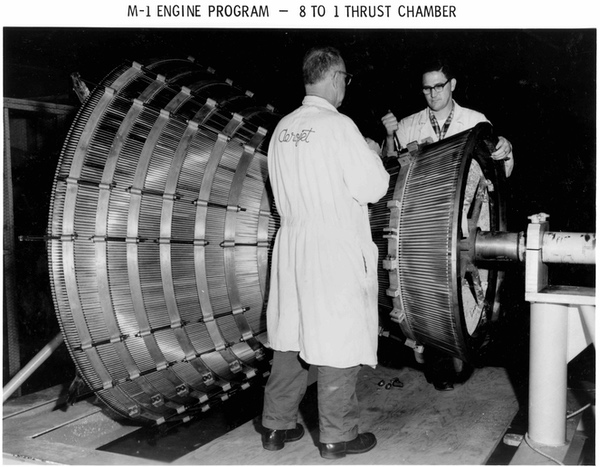 The thrust chamber for the engine. Assembling and handling the large components required specialized equipment. |
The original estimate for M-1 development was $90 million. In November 1962, contract management of the M-1 Engine Program was transferred from the George C. Marshall Space Flight Center in Huntsville to the Lewis Research Center in Cleveland, Ohio. By February 1963, the cost-plus-fixed-fee contract was $190 million for a 60-month program through preliminary flight rating test of a 1.5-million pound thrust engine. By May 1964, the cost had increased by another $32 million because NASA would not be able to meet the initial payment schedule. But this eventually rose to $230 million by January 1965—an increase of over 250% compared to the original estimate.
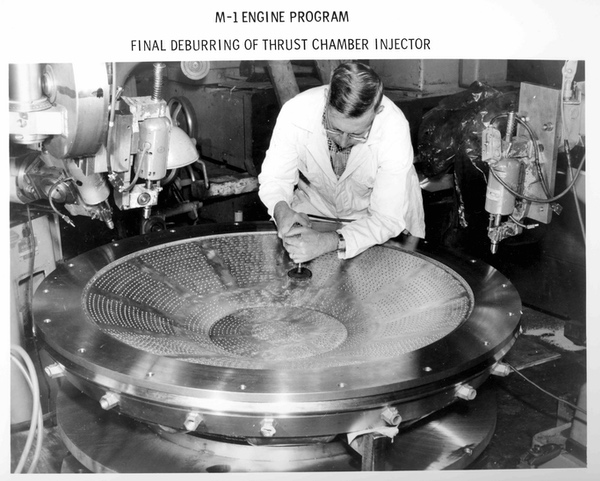 The thrust chamber injector for the M-1. This component proved troublesome for the F-1 engine. One of these injectors currently belongs to the Smithsonian's National Air and Space Museum. |
Test stands
The M-1 engine development project officially started in April 1962 and gas generator assembly testing started in May 1963. The first test of an uncooled thrust chamber assembly took place in June 1964, but there was a test stand failure. Liquid oxygen turbopump assembly testing took place in January 1965. Liquid hydrogen turbopump assembly testing took place in May 1965. Uncooled thrust chamber assembly testing took place in May 1966.
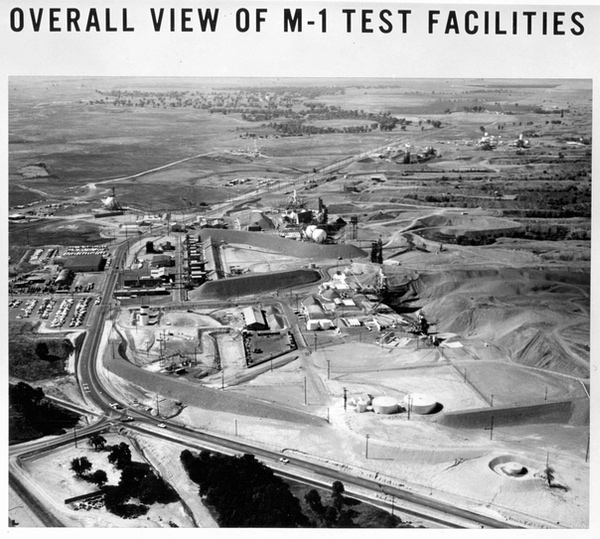 Aerojet constructed significant infrastructure for testing the M-1 before the program was canceled. |
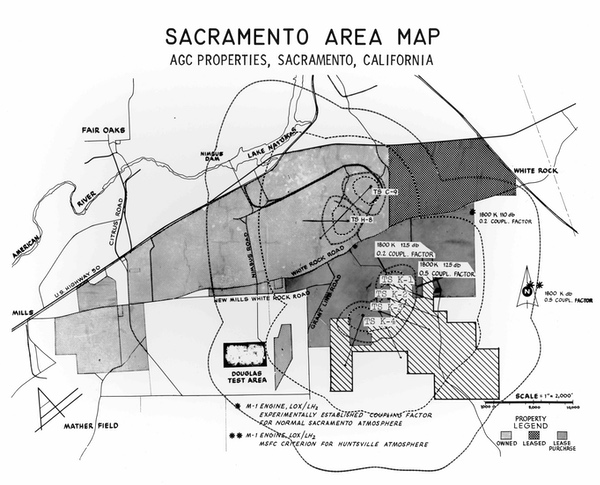 Aerojet General had a test facility outside of Sacramento, California. The M-1 engine project resulted in a significant expansion of that facility. |
To support M-1 engine development, Aerojet built a number of new test stands at its sprawling test facility outside Sacramento, California. Construction of test stand C-9, for transient evaluation and stability investigation, was started in spring 1962 and completed by 1963. Construction of test stand H-8, for thrust chamber and gas generator development, was started in May 1962 and nearly completed by 1964. Test stands E-1 and E-3 were developed for turbopump development testing and their construction was initiated in May 1962. Construction of test stand K-1, for engine altitude start and environmental testing, was started in January 1964, with the goal of beginning sea level engine tests in May 1966 and altitude starts in July 1967. Construction of test stand K-2, for conducting altitude performance and operation evaluation, was due to be started in November 1965, but did not occur.
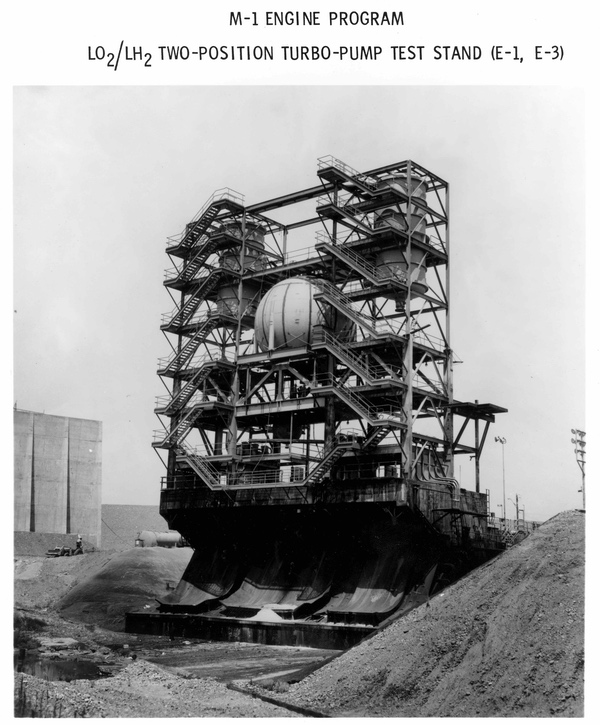 One of the M-1 component test stands located outside Sacramento, California. Because the M-1 design separated major components, many of those components could be hot-tested tested individually to identify and solve problems before the entire powerful engine was assembled. |
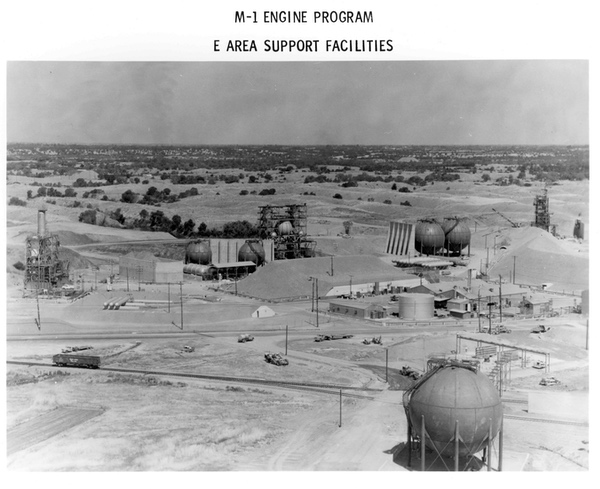 Part of the sprawling Aerojet test complex outside of Sacramento, California. Substantial infrastructure was built to test the many components of the M-1. |
They might be giants
While development of the engine was underway, Aerojet considered the rockets that it might power. One option was a two-stage, all M-1 launch vehicle. Aerojet engineers determined that with additional funds they could develop a first stage version of the engine. It would have a shorter, narrower thrust chamber nozzle that was optimized for the higher air pressure at sea level.
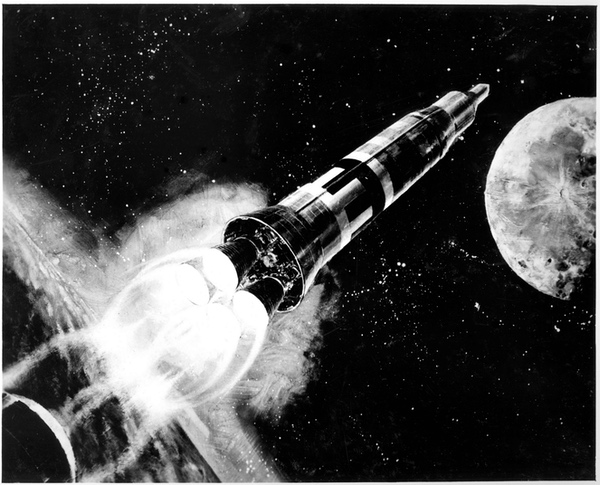 The M-1 originated as a proposal to replace hydrogen-oxygen J-2 engines in the second stage of a large, pre-Saturn V, launch vehicle. Two M-1s could replace 12 J-2s. |
Another variant was the M-1 Sea Level (Plug) version. In this configuration, the rear of the rocket vehicle would have a large, rounded extension called the plug, with rocket engines mounted around its periphery. One potential configuration included 18 M-1 engines at the base, for a total of 27 million pounds (120 million newtons) of thrust, or nearly four times as much as a Saturn V.
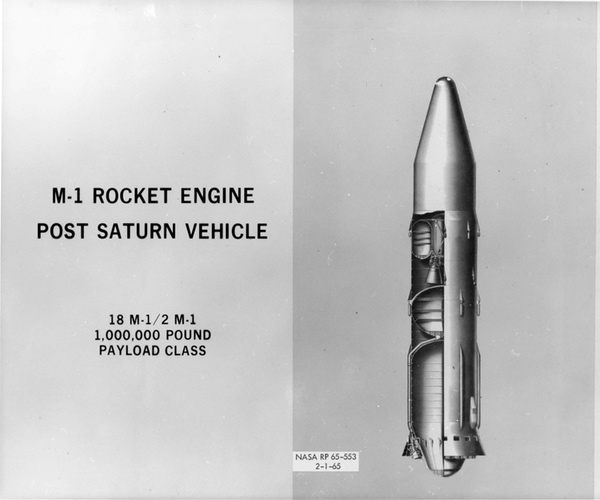 A proposed "million pound booster" rocket that would have used multiple M-1 engines mounted around a central structure as well as in the second stage. In the mid-1960s, NASA engineers believed that a very large rocket was likely required for human Mars missions. |
Aerojet engineers had not selected a method for igniting the rocket engine before the project was canceled, but one option was a fluorine gas hypergolic ignition system for both the gas generator and the thrust chamber. Some thrust chamber testing was performed with a fluorine hypergolic system. Fluorine is a notoriously dangerous fuel to use, however, and it seems doubtful that it would have been chosen for the operational design unless its benefits clearly outweighed its considerable risks.
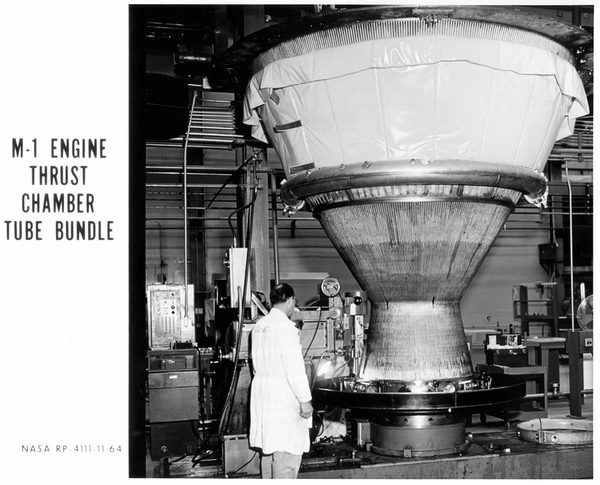 An M-1 thrust chamber under assembly. Even the separate components were large and unwieldy. |
Death of the monster
In January 1965, NASA informed Aerojet that the new NASA budget did not contain funding for the engine. NASA soon told Aerojet to stop work on parts of the project, but continue work in several major areas. Soon thereafter, Lewis Research Center was told by NASA headquarters to stop working on new major facility construction for the M-1. Some additional testing of rocket engine components continued in 1966, but it eventually came to a halt. Two modified M-1 fuel turbopumps were provided to the government for the Phoebus ground test nuclear reactor experiment.
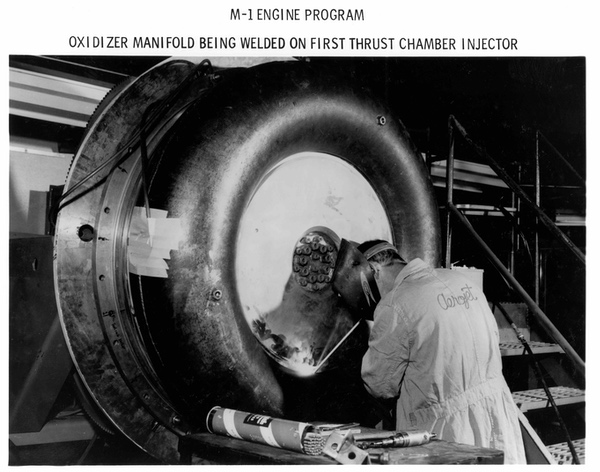 M-1 oxidizer manifold under construction. Despite being canceled, significant hardware was constructed and some of it was hot-tested in California. |
The M-1 engine reflected the early irrational exuberance of the Apollo program, when NASA officials expected that the Moon landing would be followed by further human trips to Mars. But NASA officials did more than just dream: they implemented programs that could have made some of those dreams possible. Many of those projects cost substantial amounts of money, which alarmed officials in the White House and members of Congress, who believed that they were not necessary for the ambitious but limited goal of sending humans to the Moon.
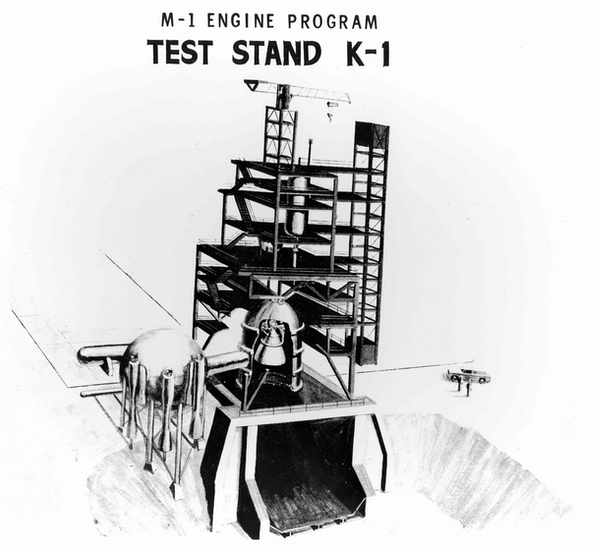 Four large test stands were planned for completed M-1 engines. Test stands K-1, K-3, and K-4 would have supported sea level test firings. They were not completed before the program was canceled. As NASA learned with the F-1, multiple test stands were often required because test failures damaged the stands and halted testing, making additional stands valuable. |
By the mid-1960s it was clear that NASA funding was peaking and post-Apollo plans were rapidly being scaled back by the White House and Congress. In this new political environment, many viewed the M-1 as an engine without a mission. Like other advanced technology projects such as the SNAP-8 nuclear reactor and the NERVA nuclear rocket engine, the lack of a program requiring it, combined with rising development costs, made it an obvious program to eliminate from the budget.
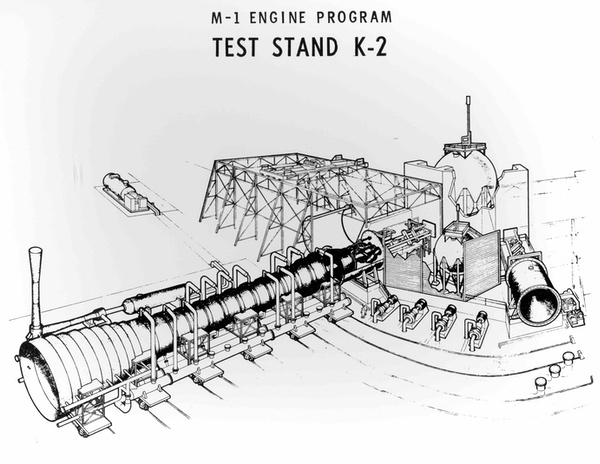 The K-2 atmospheric test stand for testing the engine at lower pressures, equivalent to higher altitudes. |
Aerojet’s experience working on the M-1 gave it an advantage when NASA began a competition for the Space Shuttle Main Engine development in the early 1970s. The SSME would also use hydrogen and oxygen. It had about one third the thrust of the M-1, and about twice the thrust of the largest operational hydrogen-oxygen engine, Rocketdyne’s J-2 used on the second and third stages of the Saturn V. Unfortunately, Aerojet’s M-1 experience was not sufficient to win the company the contract, which went to competitor Rocketdyne instead.
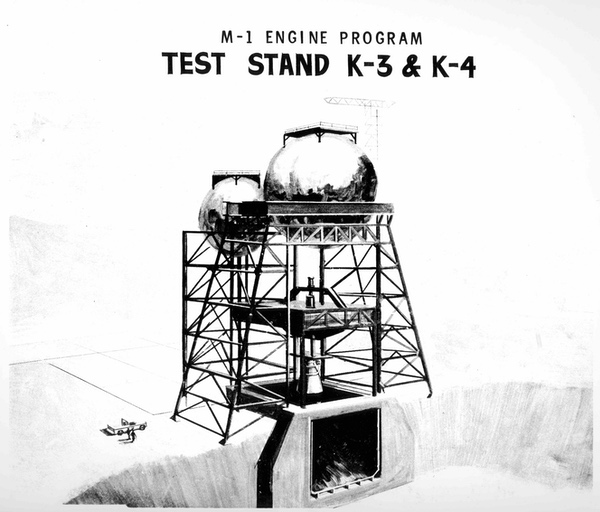 The Rocketdyne F-1 engine had numerous large test stands located throughout the United States, including in Huntsville, Alabama, and Edwards Air Force Base, California. Aerojet had a test facility outside Sacramento, and began building multiple test stands for the M-1. The largest test stands would have rivaled the ones produced for the F-1. |
Had the M-1 continued to full-scale development and testing, Aerojet’s engineers would have undoubtedly encountered significant difficulties. The F-1 engine’s problems with combustion instability, and the resulting explosions on test stands, demonstrated that big rockets present big challenges; it is the nature of the beast. With the post-Apollo scaling back of American space exploration plans, the powerful rocket engine was never needed, and the M-1’s mighty roar echoed only in the dreams of the men who worked on it.
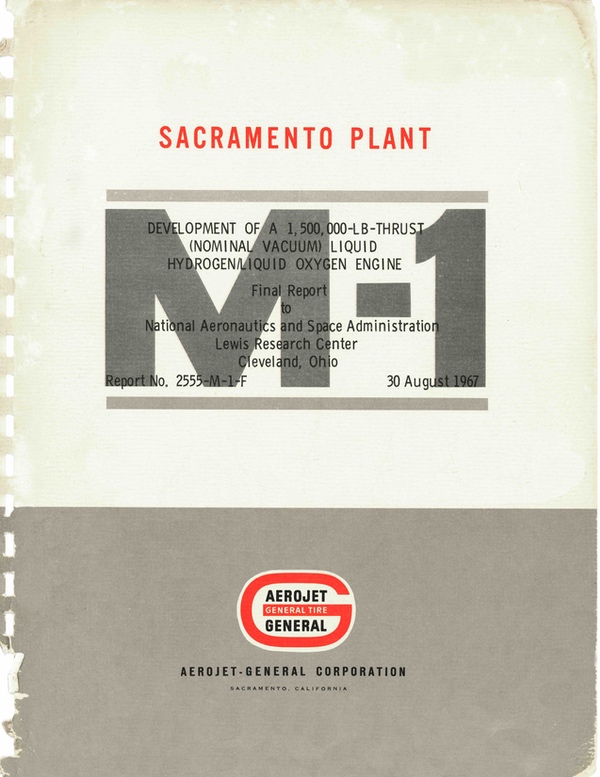 Cover of a report on the M-1 rocket engine. Even though the program was canceled in early 1965, NASA allowed some testing to continue into 1966. |
Note: we are using a new commenting system, which may require you to create a new account.
